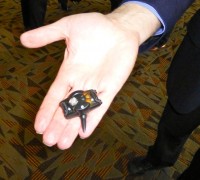By Margaret Harris at the APS March Meeting in Baltimore
In industry, the gap between making a scientific discovery and turning it into a practical product is often termed the “valley of death”. Many an idea that seemed promising in the laboratory has failed to become a real application for want of funding, industrial know-how or, usually, some combination of the two.
The Industrial Physics thread of this year’s APS March Meeting – which my colleague Louise Mayor and I are attending this week on behalf of Physics World – includes a number of talks about the “valley of death” problem, and the one that kicked off yesterday’s session really brought home the importance of addressing it. The speaker, Robert Colwell, directs the Microsystems Technology Office at the Defense Advanced Research Projects Agency. Better known by its acronym – DARPA – the agency is part of the US Department of Defense, and one of the products that physicists in Colwell’s office have developed is a “blast gauge” for soldiers deployed in Iraq and Afghanistan.
These gauges detect sudden spikes in air pressure, such as those that occur in the wake of an explosion. That’s important for the US military because spikes in pressure are a major cause of traumatic brain injuries in combat, but the extent of a soldier’s injury can be difficult to diagnose in the field – not least because, as Colwell put it, soldiers are “tough guys” who tend to say they’re okay even when they are experiencing symptoms of brain trauma such as headaches and confusion.
The gauges are small and lightweight, and when soldiers wear them – one on their back, one on their chest and one on the back of their helmet – they essentially act like dosimeters for excess pressure: at the push of a button, LED indicators on the device will glow green, yellow or red depending on the level of pressure the soldier has experienced. This information allows medics to decide what treatment (if any) an individual soldier requires, but it also helps DARPA scientists to better understand the nature of blast injuries and their causes. One surprising thing they’ve learned, Colwell said, is that the threat is far higher in training than it is in combat. For example, soldiers can get a “dose” of pressure if they stand in the wrong place when they practice firing mortars or shoulder-launched missiles.
DARPA’s blast gauges aren’t particularly complex. They’re made from commercially available components, including the same pressure sensor as in a Nintendo Wii, and at $43 each, they’re pretty cheap, too. But if it hadn’t been for the partnership that exists between DARPA physicists and their clients in the military, the gauges might have fallen into the “valley of death” – and in their absence, soldiers might have continued to acquire pressure-related injuries in training, unbeknown to anyone who could put a stop to it.
Note: a feature article on the subject of brain trauma is scheduled to appear in the April 2013 issue of Physics World.

Guidelines
Show/hide formatting guidelines
this text was deletedwhere people live in harmony with nature and animals</q>
Some text